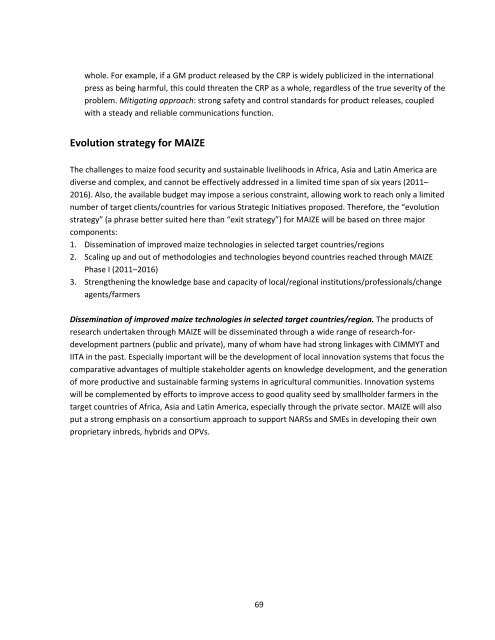Download - Maize
Download - Maize
Download - Maize
Create successful ePaper yourself
Turn your PDF publications into a flip-book with our unique Google optimized e-Paper software.
whole. For example, if a GM product released by the CRP is widely publicized in the international<br />
press as being harmful, this could threaten the CRP as a whole, regardless of the true severity of the<br />
problem. Mitigating approach: strong safety and control standards for product releases, coupled<br />
with a steady and reliable communications function.<br />
Evolution strategy for MAIZE<br />
The challenges to maize food security and sustainable livelihoods in Africa, Asia and Latin America are<br />
diverse and complex, and cannot be effectively addressed in a limited time span of six years (2011–<br />
2016). Also, the available budget may impose a serious constraint, allowing work to reach only a limited<br />
number of target clients/countries for various Strategic Initiatives proposed. Therefore, the “evolution<br />
strategy” (a phrase better suited here than “exit strategy”) for MAIZE will be based on three major<br />
components:<br />
1. Dissemination of improved maize technologies in selected target countries/regions<br />
2. Scaling up and out of methodologies and technologies beyond countries reached through MAIZE<br />
Phase I (2011–2016)<br />
3. Strengthening the knowledge base and capacity of local/regional institutions/professionals/change<br />
agents/farmers<br />
Dissemination of improved maize technologies in selected target countries/region. The products of<br />
research undertaken through MAIZE will be disseminated through a wide range of research‐fordevelopment<br />
partners (public and private), many of whom have had strong linkages with CIMMYT and<br />
IITA in the past. Especially important will be the development of local innovation systems that focus the<br />
comparative advantages of multiple stakeholder agents on knowledge development, and the generation<br />
of more productive and sustainable farming systems in agricultural communities. Innovation systems<br />
will be complemented by efforts to improve access to good quality seed by smallholder farmers in the<br />
target countries of Africa, Asia and Latin America, especially through the private sector. MAIZE will also<br />
put a strong emphasis on a consortium approach to support NARSs and SMEs in developing their own<br />
proprietary inbreds, hybrids and OPVs.<br />
69

















